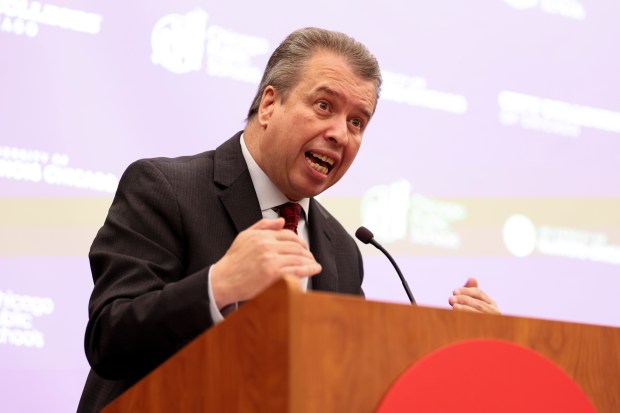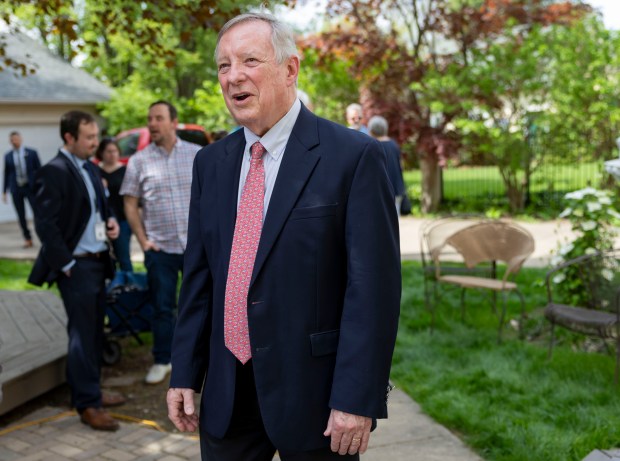Chicago Public Schools officials expressed the urgency of additional funding from the city and state as they prepare for the release of “school-level budgets,” with the assumption that they will have $300 million in extra money from stakeholders to fill a gaping budget gap.
School-level budgets, or the funds each school gets to cover everyday needs like staff, supplies and programs, are part of the process for finalizing the budget for the 2026 fiscal year which begins July 1. They will be released to principals on Thursday.
There are additional challenges in the upcoming school year, officials told reporters in a briefing Wednesday, due to the expiration of federal pandemic relief funding, rising prices and greater student needs. CPS faces an estimated $529 million shortfall heading into next year.
But outgoing schools chief Pedro Martinez said the district is moving ahead under the assumption that it will receive $300 million in additional money from either the city or the state, and prioritize cost-saving measures that avoid impacting schools directly.
In his briefing with reporters, Martinez did not mince words.
“This is a tough budget season,” he said. “I’m urgently calling all of our city partners, the mayor, the city council, all of our stakeholders to come together.”
The biggest uncertainty on principals’ minds is school-level cuts in the form of over 1,000 layoffs, which the district floated in a presentation given to board members and obtained by the Tribune in late April.
In a separate briefing with reporters Wednesday afternoon, Kia Banks, vice president of the union representing principals, called the CPS budget projection “very irresponsible.” The Chicago Principals & Administrators Association sent a member-facing letter earlier in the day to inform them of the union’s concerns with the prepared budget.
“We have to have conversations that can ensure us that there is a real plan, a viable plan that will ensure that the budget deficit will be filled by revenue,” Banks said. “And that is for the powers to be to solve.”
Martinez said Wednesday that his top request is for more funding from the state. But if that doesn’t come through, CPS is looking to rely on additional tax increment financing (TIF) dollars — money the city sets aside from property taxes to support development in certain neighborhoods.
When property values go up in a TIF district, the extra tax money, which would help fund services like public schools, is instead used for things like new buildings, infrastructure, or job programs aimed at boosting the local economy. This has raised concerns among some CPS parents and advocates, who say schools lose out on that funding.
“I’m a Chicago kid. I’ve seen how TIFs have helped our downtown,” said CPS graduate Martinez on Wednesday. “We need long-term TIF reform.”
Martinez argued that over $1.2 billion in property taxes are diverted from CPS every year, depriving the district of over $600 million in revenue.
Aldermen are in charge of allocating TIF money in their districts. When they decide they don’t need all the extra property tax money, some of the extra TIF funds are returned to CPS, called the TIF surplus. In recent years, the district has received tens of millions of dollars that way.
Martinez made a similar plea to aldermen last year and received a record amount of $311 million when the city settled its budget over the winter. But Chicago’s City Council faces its own fiscal challenges in the upcoming budget season.
And the $529 million shortfall already assumes $300 million in TIF surplus.
Another unresolved issue is a $175 million pension payment for non-teacher staff, a cost the city used to cover but has now shifted to the school district. CPS punted that responsibility back to the city this year.
This spring’s school-level budgets were several weeks behind, partly due to a change in district leadership and the transition to a new, 21-member hybrid school board, according to CPS officials.
Martinez, who was fired without cause by the school board in December of last year, largely for refusing to take out a loan request by Mayor Brandon Johnson to balance last year’s budget, hinted at that transition Wednesday. Typically, board members give direction to district officials about balancing the budget. The CPS chief executive officer said they’ve given “little feedback.”
He also made a pointed remark about his exit from the financial challenges bearing down on the fourth-largest school district in the nation.
“I’m moving to Massachusetts,” he said. “My family and I are moving.”
Variation in school-level budgets will be allocated based on enrollment, with additional resources for schools with emergent needs, said Mike Sitkowski, the district’s chief budget officer. If the $300 million in TIF money doesn’t come through and the district is stuck with $529 million in deficit, CPS is preparing models for school-level impact at elementary and high schools of varying sizes.
Typically, principals take three weeks to assess their allocations, which are finalized in early June. The official and finalized budget must pass at the monthly school board meeting in August.
Banks, of the principals union, said school leaders were directed Wednesday to proceed with the assumption that the projection of funding would come through. But she also blasted Martinez for his assumption.
“Whatever Pedro Martinez says, he won’t be here to enforce, so he is not capable of giving us the commitment that we deserve,” she said. “It’s very easy to be vague and engage in political posturing when you have one foot out of the door.”





